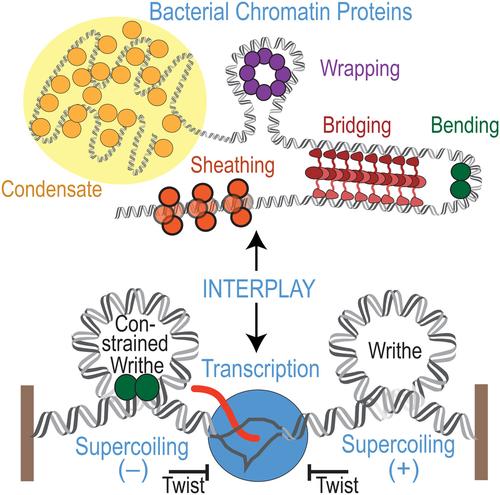当前位置:
X-MOL 学术
›
Mol. Microbiol.
›
论文详情
Our official English website, www.x-mol.net, welcomes your
feedback! (Note: you will need to create a separate account there.)
Bacterial chromatin proteins, transcription, and DNA topology: Inseparable partners in the control of gene expression
Molecular Microbiology ( IF 2.6 ) Pub Date : 2024-06-07 , DOI: 10.1111/mmi.15283 Christine M Hustmyer 1 , Robert Landick 1, 2
Molecular Microbiology ( IF 2.6 ) Pub Date : 2024-06-07 , DOI: 10.1111/mmi.15283 Christine M Hustmyer 1 , Robert Landick 1, 2
Affiliation

|
DNA in bacterial chromosomes is organized into higher-order structures by DNA-binding proteins called nucleoid-associated proteins (NAPs) or bacterial chromatin proteins (BCPs). BCPs often bind to or near DNA loci transcribed by RNA polymerase (RNAP) and can either increase or decrease gene expression. To understand the mechanisms by which BCPs alter transcription, one must consider both steric effects and the topological forces that arise when DNA deviates from its fully relaxed double-helical structure. Transcribing RNAP creates DNA negative (−) supercoils upstream and positive (+) supercoils downstream whenever RNAP and DNA are unable to rotate freely. This (−) and (+) supercoiling generates topological forces that resist forward translocation of DNA through RNAP unless the supercoiling is constrained by BCPs or relieved by topoisomerases. BCPs also may enhance topological stress and overall can either inhibit or aid transcription. Here, we review current understanding of how RNAP, BCPs, and DNA topology interplay to control gene expression.
中文翻译:

细菌染色质蛋白、转录和 DNA 拓扑结构:控制基因表达的不可分割的伙伴
细菌染色体中的 DNA 通过称为类核相关蛋白 (NAP) 或细菌染色质蛋白 (BCP) 的 DNA 结合蛋白组织成高级结构。BCP 通常与 RNA 聚合酶 (RNAP) 转录的 DNA 基因座结合或靠近,并且可以增加或减少基因表达。要了解 BCP 改变转录的机制,必须考虑空间效应和 DNA 偏离其完全松弛的双螺旋结构时产生的拓扑力。每当 RNAP 和 DNA 无法自由旋转时,转录 RNAP 会在上游产生 DNA 负 (-) 超螺旋,在下游产生正 (+) 超螺旋。这种 (-) 和 (+) 超螺旋产生拓扑力,抵抗 DNA 通过 RNAP 向前转位,除非超螺旋受到 BCP 的限制或被拓扑异构酶缓解。BCP 还可以增强拓扑应激,总体上可以抑制或帮助转录。在这里,我们回顾了目前对 RNAP、BCP 和 DNA 拓扑如何相互作用以控制基因表达的理解。
更新日期:2024-06-07
中文翻译:

细菌染色质蛋白、转录和 DNA 拓扑结构:控制基因表达的不可分割的伙伴
细菌染色体中的 DNA 通过称为类核相关蛋白 (NAP) 或细菌染色质蛋白 (BCP) 的 DNA 结合蛋白组织成高级结构。BCP 通常与 RNA 聚合酶 (RNAP) 转录的 DNA 基因座结合或靠近,并且可以增加或减少基因表达。要了解 BCP 改变转录的机制,必须考虑空间效应和 DNA 偏离其完全松弛的双螺旋结构时产生的拓扑力。每当 RNAP 和 DNA 无法自由旋转时,转录 RNAP 会在上游产生 DNA 负 (-) 超螺旋,在下游产生正 (+) 超螺旋。这种 (-) 和 (+) 超螺旋产生拓扑力,抵抗 DNA 通过 RNAP 向前转位,除非超螺旋受到 BCP 的限制或被拓扑异构酶缓解。BCP 还可以增强拓扑应激,总体上可以抑制或帮助转录。在这里,我们回顾了目前对 RNAP、BCP 和 DNA 拓扑如何相互作用以控制基因表达的理解。






























 京公网安备 11010802027423号
京公网安备 11010802027423号